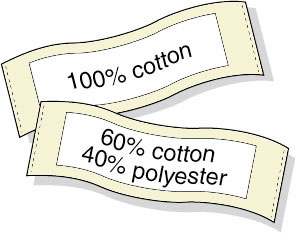3 Percentages
3.1 What are percentages?
Percentages are used, particularly in newspaper articles, to indicate fractions (as in ‘64% of the population voted’) or to indicate changes (as in ‘an increase of 4%’).
Percentages often indicate proportions. For example, labels in clothes indicate the various proportions of different yarns in the fabric. ‘Per cent’ means ‘per hundred’ and is denoted by the symbol %. 100% is the same as the whole, or one hundred per hundred.

100% cotton indicates that the fabric is made entirely from cotton. (100 parts out of 100 parts).
60% cotton means that ![]() (or 0.6) of the fabric is cotton.
(or 0.6) of the fabric is cotton.
40% polyester means that ![]() (or 0.4) is polyester.
(or 0.4) is polyester.
The percentages on the label should total 100%, just as the corresponding fractions add up to 1, because the total (100%) refers to the whole garment. 60% + 40% = 100%, 0.6 + 0.4 = 1.
Percentages can also be manipulated as either fractions or decimals.
Example 10
A building society offers 90% mortgages to first-time buyers. How much would the Smiths get on a house valued at £150 000?
Answer
They want to find 90% of £150 000. 90% = ![]() = 0.9.
= 0.9.
0.9 × 150 000 = 135 000
So the Smiths would get £135 000.
